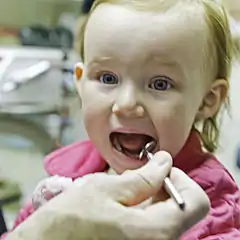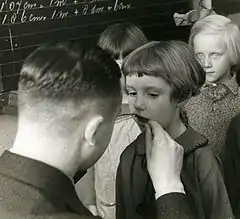Pediatric dentistry
Pediatric dentistry (formerly pedodontics in American English or paedodontics in Commonwealth English) is the branch of dentistry dealing with children from birth through adolescence.[1] The specialty of pediatric dentistry is recognized by the American Dental Association,[2] Royal College of Dentists of Canada,[3] and Royal Australasian College of Dental Surgeons.[4]



Pediatric (also paediatric or pædiatric) dentists promote the dental health of children as well as serve as educational resources for parents. It is recommended by the American Academy of Pediatric Dentistry (AAPD) and the American Academy of Pediatrics (AAP) that a dental visit occurs after the presence of the first tooth or by a child's first birthday. The AAPD has said that it is important to establish a comprehensive and accessible ongoing relationship between the dentist and patient – referring to this as the patient's "dental home".[5] This is because early oral examination aids in the detection of the early stages of tooth decay. Early detection is essential to maintain oral health, modify aberrant habits, and treat as needed and as simply as possible. Additionally, parents are given a program of preventive home care (brushing, flossing and fluorides), a caries risk assessment, information on finger, thumb, and pacifier habits, and may include advice on preventing injuries to the mouth and teeth of children, diet counseling, and information on growth and development.
History
In 1909 Minnie Evangeline Jordon established the first dental practice in the United States devoted only to pediatric patients.[6] In 1925 she published the first textbook on pediatric dentistry, titled Operative Dentistry for Children.[7][8][9][10] The first dental care brought to public school was Alfred Fones in 1914, which was near 6 decades after the first woman, Lucy Hobbs Taylor, who received a DDS.[11]
Education
Pediatric dentistry is one of the ten dental specialties recognized by American Dental Association. Other specialties include dental public health, endodontics, oral and maxillofacial pathology, oral and maxillofacial radiology, oral and maxillofacial surgery, orthodontics and dentofacial orthopedics, periodontics, and prosthodontics.
The first step would be obtaining a college degree in biomedical science, health science, or social science as long as all biomedical course pre-requisites are met [12] courses. While in college, one can explore the profession by shadowing in a pediatric dental office or children's hospital, or working on academic research that studies oral health of children.
Second step would be attending a dental school that involves four years of education and training. One can graduate with Doctor of Dental Surgery (DDS) or Doctor of Dental Medicine (DMD). Both degrees are equivalent and people receive the same training as required by the CODA(The Commission on Dental Accreditation). During the first two years of dental school, dental students will take didactic classes on biomedical sciences and hands on classes to learn technical procedures in a pre-clinical laboratory setting. Third and fourth years of dental school focus on clinical care under the supervision of attending faculty who are licensed dentists. Before graduating, all dental students must pass National Board Dental Examination part I and part II, as well as clinical skill exams (e.g., ADEX, WREB, etc) to become a licensed general dentist.
In order to specialize in pediatric dentistry, one should receive additional in-depth training from an accredited postgraduate residency program.[13] Pediatric dentistry residency program can be 24 months or more in length. At the end, resident dentists are awarded a certificate in pediatric dentistry with or without a master's degree depending on their program type. Specialized training covers all aspects of oral health care from infancy through adolescence, encompassing behavior management, preventive dentistry, restorative dentistry, sedation dentistry, oral trauma management, interceptive orthodontics, oral medicine and pathology. The majority of residency training is spent on treating pediatric patients in a dental clinic or hospital operating room where the patient is under general anesthesia.[14]
Following successful completion of post-graduate training, one becomes Board-eligible for the American Board of Pediatric Dentistry(ABPD) examination. The first part of the Board exam is a written exam. Once passing the written exam, one moves on to the second part, which is an oral examination testing on clinical knowledge. Successful completion of board certification results in Diplomate status in the American Board of Pediatric Dentistry that allows one to practice as a Board-certified pediatric dentist.
Job Description
Responsibilities of a pediatric dentist include:
- Diagnose and treat oral disease(preventive and restorative)
- Interpret x-rays and other diagnostic tests
- Formulate treatment plans to restore oral health of pediatric patients including healthy one and those with special health care needs
- Monitor growth and development of all teeth and jaws
- Treat dental malocclusion interceptive orthodontic treatment and/or orthodontics
- Perform surgical procedures on teeth, bone, and soft tissues of the oral cavity
- Provide emergency care(dental infection, pain, and dental trauma)
- Treat pediatric patients under different levels of sedation(minimal, moderate, or deep) and general anesthesia
Career Outlook
It has been reported by the U.S. Bureau of Labor Statistics job demand for pediatric dentist will grow by 20% from 2014-2024. As of July 17th 2021, the average annual pay for a pediatric Dentist in the United States is $245,671. Most pediatric dentists work in private dental offices either as an associate dentist or an owner. They can also choose an academic route to conduct research and train dental residents.
See also
- Dentistry for babies
- School health services
- Special needs dentistry
- Hall Technique
- Minnie Evangeline Jordon
- Pediatric crowns
References
- "What is a Pediatric Dentist?". HealthyChildren.org. 2013-11-05. Retrieved 2014-08-01.
- "Specialty Definitions". Ada.org. Retrieved 2014-08-01.
- "RCDC – Specialties". Rcdc.ca. Retrieved 2014-08-01.
- Paediatric dentistry (requires log-in)
- "Definition Of A Dental Home" (PDF). AAPD. June 3, 2013. Retrieved 2013-06-03.
- Richard A. Glenner (1997). How it evolved: dentistry's pursuit for excellence. ADR Publishing.
- "M. Evangeline Jordan-Pedodontics" Sindecuse Museum, University of Michigan School of Dentistry.
- Loevy, H. T.; Kowitz, A. A. (Spring 2006). "M. Evangeline Jordon, Pioneer in Pedodontics". Journal of the History of Dentistry. 54 (1): 3–8. PMID 16764231.
- M. Evangeline Jordon, Operative Dentistry for Children (1925).
- Alma Whitaker, "Fame Won as Dentist by Woman" Los Angeles Times (April 7, 1933): A5. ProQuest 163114590
- "10 women in dentistry that have made an impact". Dental Lifeline Network. Retrieved 2021-03-26.
- Carver, Rebecca B. (2016-04-29). "Promoting health literacy among non-science undergraduates". Science & Education. 25 (5–6): 737–740. doi:10.1007/s11191-016-9830-x. ISSN 0926-7220. S2CID 147749151.
- "How to Become a Pediatric Dentist". Doctorly.org. Retrieved 2017-03-27.
- "Pediatric Dentistry Careers: Job Options and Education Requirements". Study.com. Retrieved 2017-03-29.
- "Dentists: Doctors of Oral Health". www.ada.org. Retrieved 2017-04-03.
External links
Organizations